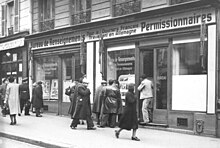Service du travail obligatoire
The Service du travail obligatoire (STO, "compulsory labor service") was an organization for the recruitment of French skilled workers by the Vichy regime for use in the German war economy . The STO was founded in February 1943 after the predecessor organization Relève ( French for replacement team, offspring) from 1942, which was also based on laws of the Vichy regime, had failed because only 50,000 workers registered at Fritz Sauckel's original request had.
In return for 150,000 French skilled workers requested in 1942 alone, 50,000 French prisoners of war were to be released to their homeland. This apparently humanitarian gesture was unmasked as a coercive measure both by the poor working and nutritional conditions (exception: agriculture) and by the long uprooting from home . It served the German war machine, because in fact all promises were not kept by the German side, instead more workers and skilled workers were required. The Releve in its “voluntary” form turned out to be a failure.
In order to meet the German demands under the General Plenipotentiary for Labor Employment , Fritz Sauckel , for more and more workers, the Vichy government was forced to enact registration laws that stipulated a two-year obligation to work for the baby boomers 1920 to 1922. This enabled the first two recruitment requirements to be met successfully.
The four Sauckel actions in France resulted in:
| action | German demand | Period | French measure | Result |
|---|---|---|---|---|
| 1 | 250,000 men including 150,000 skilled workers |
June to December 1942 |
Releve (June 22); 1. Compulsory measure (September 4th) |
approx. 250,000 (135,000 skilled workers) |
| 2 | 250,000 men including 150,000 skilled workers |
January to April 1943 |
STO Act (February 16) | approx. 250,259 (157,020 skilled workers) |
| 3 | 240,000 | May to October 1943 |
Tightening of the STO law | approx. 105,610 (25,640 skilled workers) |
| 4th | 1,000,000 reduced to 885,000 |
January to June 1944 |
stricter comb-out bodies | 36,000 to 50,000 |
| 1,625,000 | 631.869 to 645.869 |
So were thousands z. B. employed at the Reichsbahn , which was one of the preferred targets of the tactical Allied bombing raids . Usually housed in barracks near repair works or railway junctions , numerous French workers also fell victim to the bombs when there was no space for them in the air raid shelters .
For many young French people, the STO meant having to choose between forced labor in the German Reich and diving into the French underground , or even participating in the armed fighting in the Maquis . The increasingly frequent decision in favor of the latter meant a considerable increase in personnel for the Maquisards.
French forced laborers (like those of other nations) also participated in the active resistance against National Socialism in Germany. B. in Berlin with the European Union network .
literature
- Helga Bories-Sawala: French in the "imperial deployment". Deportation, forced labor, everyday life; Experiences and memories of prisoners of war and civil workers Lang, Frankfurt 1996 ISBN 3-631-50032-7 (also Univ. Diss. Bremen 1995) 3 volumes
- this. & Rolf Sawala: "J'écris ton nom: Liberté!" La France occupée et la Résistance Schöningh, Paderborn (2002) ISBN 3140455003 (source collection in French, classification of the STO in Nazi war policy, poster of the STO, leaflet of the Resistance against it)
- Roger Frankenstein: The German labor evictions in France and the cooperation of French companies with the occupying power, 1940-1944 . In: Second World War and Social Change . Ed .: Waclaw Dlugoborski, Vandenhoeck & Ruprecht 1981, ISBN 3-525-35705-2 .
- Harry R. Kedward: In Search of the Maquis. Rural Resistance in Southern France 1942–1944 (Eng.) 2nd ed. Oxford Univ. Press 1994, ISBN 0198205783 .
- The Relève through the filter of propaganda, from the Photographic Collection of Vichy in: Collaboration and resistance. Images of life in Vichy France Ed. Documentation Française. Engl .: Harry N. Abrams, NY 2000 (first French 1988) ISBN 0810941236 , Appendix 2, pp. 249-253 (numerous images)
Web links
Individual evidence
- ^ Roger Frankenstein: The German labor evictions in France and the cooperation of French companies with the occupying power, 1940-1944 . In: Second World War and Social Change . Ed .: Waclaw Dlugoborski, Vandenhoeck & Ruprecht 1981, ISBN 3-525-35705-2 , p. 213.
- ^ Roger Frankenstein: The German labor evictions in France and the cooperation of French companies with the occupying power, 1940-1944 . In: Second World War and Social Change . Ed .: Waclaw Dlugoborski, Vandenhoeck & Ruprecht 1981, ISBN 3-525-35705-2 , p. 213.
- ^ Roger Frankenstein: The German labor evictions in France and the cooperation of French companies with the occupying power, 1940-1944 . In: Second World War and Social Change . Ed .: Waclaw Dlugoborski, Vandenhoeck & Ruprecht 1981, ISBN 3-525-35705-2 , p. 220.

